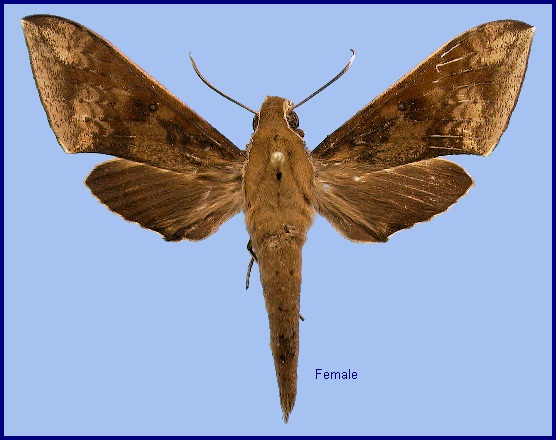
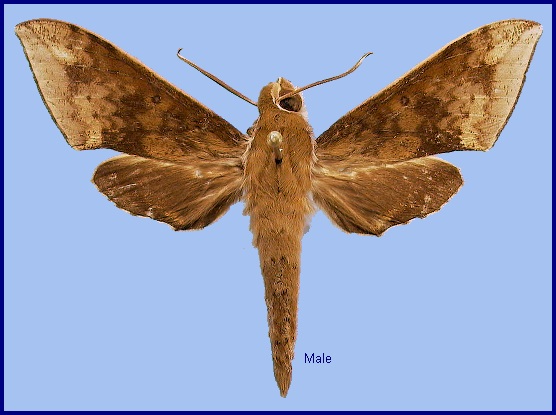
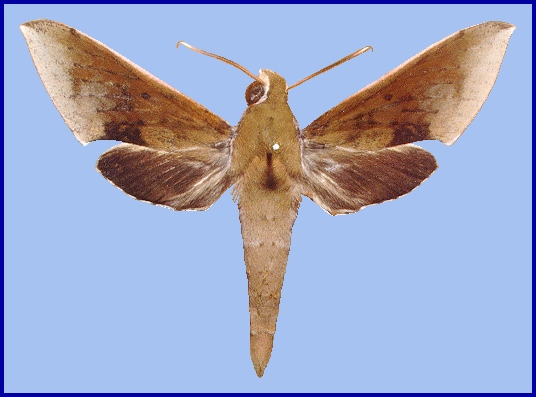
Pergesa velata Walker, 1866, List Specimens lepid. Insects Colln Br. Mus. 35: 1853. Type locality: [India, West Bengal,] Darjeeling.
Synonym. Pergesa velata Walker, 1866.
Synonym. Theretra velata Dudgeon, 1898.
Wingspan: 66--74mm. Male similar to Rhagastis confusa Rothschild & Jordan, 1903, but much smaller in size. Forewing apex protruding but not falcate. Upperside with the four postmedian lines forming a conspicuous dark triangular patch on the inner margin that is often continued towards the costa where it joins another (not always well-marked) patch near the discal spot; two or three of the postmedian lines usually strongly dentate. Outer margin more curved; black zigzag lines on the forewing upper side expanding as a large black patch reaching the inner margin; underside colour tends to be ochre, with many black fragmented spots dotted; the deep gray patch at the base is disconnected from the brown-grayish patch covering the submarginal area; patch colour near hindwing tornus tends to be orange. Forewing underside with brown border widened anterior to vein M3, sometimes almost as far as the basal area. Hindwing underside without a small black discal spot. The grayish zigzag medial line on the forewing and hindwing underside is much more faded than in Rhagastis confusa. Female similar to the male but with broader wings; patterns of the forewing and hindwing more faded than in the male (Jiang et al., 2024).
Labial palp segment 1 apical cavity distinct; second segment longer than broad, not narrowed to base. Metanotum without black medial dot. Upperside of abdomen without a pair of lateral golden stripes or (occasionally) with vestigial stripes on the posterior segments. Outer row of forebasitarsal spines simple or doubled only at base.
Male genitalia similar to that of Rhagastis confusa. The uncus and gnathos are more curved and slenderer; gnathos long, parallel-sided, obtusely rounded apically. Sacculus slender and curved upward apically like a spike. Valve with large paired stridulatory scales. Harpe similar to Rhagastis acuta, but rather more curved. The phallus is longer and straighter, the anterior lobe of the process is slender, and the narrow side is sharper than in Rhagastis confusa. It is symmetrical, both processes having several irregular rows of small teeth along the proximal edge.

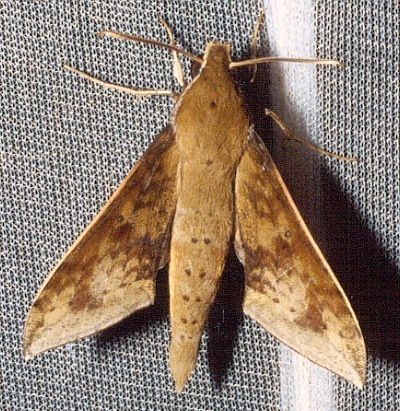
The moths visit flowers after dark, but are not known to come to light (Bell & Scott, 1937).
China: vi (Guizhou); viii (Yunnan); ix (Shaanxi).
OVUM: Very pale yellowish-green (Bell & Scott, 1937).
LARVA: Full-fed 70mm. According to Bell & Scott (1937), in the first instar pale yellow when first hatched. After feeding head yellow, body green, horn black, straight, of medium length. In the second instar, head pale green, body pale bluish-green; horn of medium, length, straight, black with base reddish, tip white; covered with small tubercles. By the third instar, head and segments 2 and 3 green, rest of body pale bluish-green with short dark longitudinal stripes; a narrow dark green dorsal stripe from 2 to base of horn; a dorso-lateral stripe pale yellow on segments 2 to 4, pale blue edged above with green from 6 to base of horn; seven dark green oblique stripes; an eye-spot on 5, which is swollen, pupil dark blue in which are one or two white spots, edged broadly with white and then narrowly with dark blue; horn long, curved slightly upwards, basal third red, middle third black, end third white, with black tubercles. In the fourth instar larvae may remain green, or become dark-coloured. In the green form, head and body bluish-green, body with short alternate pale and dark longitudinal stripes across the secondary rings; other stripes as in third instar; eye-spot with pupil dark blue in which are one large and several small white dots, this edged with green, the whole edged narrowly with white in front, yellow elsewhere; horn with basal two-thirds reddish, distal third white. In the dark-coloured form the head is reddish-brown, body a beautiful crimson; dorso-lateral stripe pale crimson, with a white dot above it on each secondary ring, and edged above with dark crimson; eye-spot with pupil dark greenish-brown with white dots, edged narrowly with white above, yellow elsewhere, the whole edged narrowly with dark brown.
In the fifth instar, surface of head dull. Body smooth, with a velvety texture; horn rather short, slightly down-curved, tapering evenly to a point; surface covered with small tubercles. In colour, head pale brown. Body very dark brown above the dorso-lateral stripe, pale brown below it, without the short longitudinal stripes of the earlier instars; a narrow black dorsal stripe on segments 2 to 4 and from 6 to base of horn; a pale yellowish-brown dorso-lateral stripe from segment 2 to base of horn, broken by the eye-spot; just below the upper edge of this stripe a round white dot on each secondary ring of segments 5 to 12; eye-spot on 5 round, the large pupil dark brown edged narrowly with white behind and reddish-brown elsewhere, the whole edged narrowly with black; oblique stripes on segments 5 to 11 formed of brown reticulations. Horn dark brown; legs reddish. Spiracles pale brown edged with black (Bell & Scott, 1937).
The larva, when in the later instars, often rests on the stem of the plant, low down among the surrounding herbage. The anterior segments are not so strongly retractile as in others of the genus. The colour becomes darker, with a greasy appearance, before pupation (Bell & Scott, 1937).
PUPA: 50--55mm. Tongue-sheath not much projecting. Surface dull and slightly rugose. Cremaster wedge-shaped, the sides inclined slightly inwards, the tip broadly rounded and bearing two conical, polished shafts, widely separated and nearly parallel with each other, each shaft dividing near tip into two short diverging arms; upper surface rugose, underside deeply concave; a dorso-lateral spine near base. Colour of head, thorax and wing-case very dark brown, rest of body pale brown with numerous short longitudinal lines; spiracles black, cremaster brown, the shafts black (Bell & Scott, 1937).
The pupa is very sluggish and rigid, the only perceptible movement made when handled being a quivering which can be detected by pressing gently on the bevels of the free abdominal segments (Bell & Scott, 1937).
Larval hostplants. In India on Arisaema and Amorphophallus (Araceae) (Bell and Scott, 1937).
Unknown.
China: Shaanxi (Xunyang, 1380m); Sichuan (Yanbian, 1840m); Yunnan (Yingjiang County, Xima Town, 1007m; Jinghong, 870m; Xishuangbanna); Guizhou (Fanjingshan, Tongren County; Anshun, 890m).
Taiwan: Nantou Hsien (Huisun forest). [Almost certainly an erroneous record.]
Nepal, Bhutan (Irungbam & Irungbam, 2019), northern India (Uttarakhand), Myanmar/Burma (Mt. Taunggyi), Thailand (Chiang Mai), central and southern China, ?Taiwan.
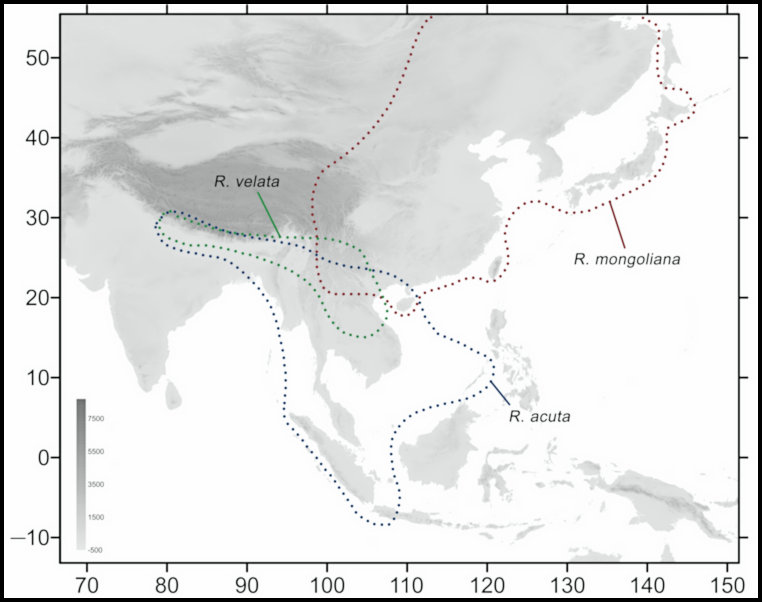
Map: Distribution of three ungrouped species of genus Rhagastis found in China. The blue dotted line indicates the range of R. acuta, the red dotted line indicates the range of R. mongoliana, and the green dotted line indicates the range of R. velata (© Jiang, Wang, Xu, Kitching, Huang, Hu & Xiao, 2024).
 Return to Sphingidae of the Eastern Palaearctic species list
Return to Sphingidae of the Eastern Palaearctic species list